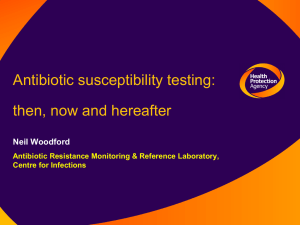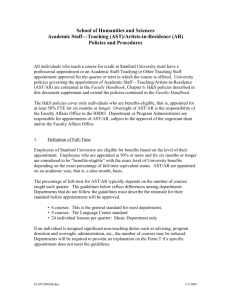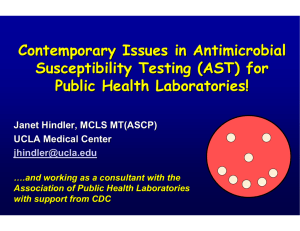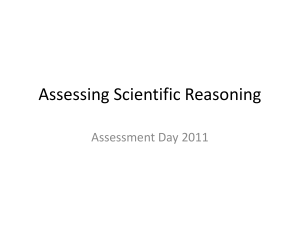Automated systems
advertisement
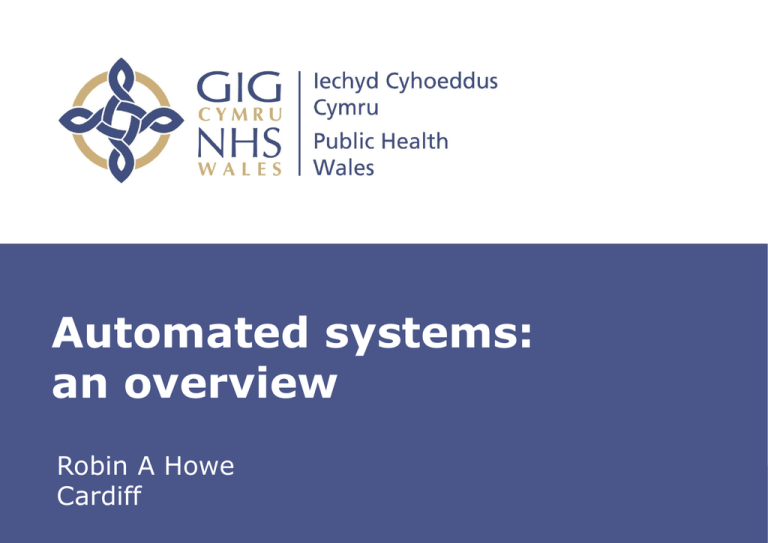
Automated systems: an overview Robin A Howe Cardiff Insert name of presentation on Master Slide AST standards • MIC taken as standard measure of susceptibility – Agar dilution – Broth dilution – Microbroth dilution • ISO standard – Broth microdiluion – Mueller-Hinton Broth – Inoculum 5x105 cfu/mL AST standards • MIC taken as standard measure of susceptibility – Agar dilution – Broth dilution – Microbroth dilution • S/I/R Breakpoints defined by BSAC/EUCAST/CLSI AST standards • MIC taken as standard measure of susceptibility – Agar dilution – Broth dilution – Microbroth dilution • S/I/R Breakpoints defined by BSAC/EUCAST/CLSI • MIC/BP supplemented by “expert rules” for clinical use The rationale for automated systems • More reliable AST results – ?closer to “standard” – Reduced scope for “user” error – Reproducible • Improved ID linked to AST • Embedded expert rules Automated systems: an overview Identification required for interpretation of BP & expert rules Welsh variability in ID of Enterobacter/Klebsiella/Serratia Inter-laboratory ID comparisons 100% % Agreement 90% 80% 70% 60% 50% 40% 94.4 93.1 ID Disagree 95.5 75.0 66.9 74.7 30% 20% ID Agree Genus ID Agree 10% 0% Lab 1 Lab 2 Lab 3 Lab 4 Laboratory Lab 5 Total The rationale for automated systems • • • • • More reliable AST results Improved ID linked to AST Embedded expert rules Improved speed of results Increased number of agents tested Automated systems: an overview Welsh Gram positive panel Drug Gentamicin Penicillin Oxacillin Ampicillin Amoxicillin/Clav Levofloxacin Ciprofloxacin Cefoxitin Linezolid Erythromycin Clindamycin Daptomycin Chloramphenicol Nitrofurantoin Fusidic Acid Rifampin Minocycline Mupirocin Mupirocin - HL Teicoplanin Tetracycline Trimethoprim Vancomycin GM-Syn ST-Syn Range 1-4 0.06 - 0.25 1-4 2 - 16 1/0.5 - 16/8 0.5 - 2 0.5 - 2 2-8 2-8 0.25 - 1 0.25 - 1 1 - 16 1 - 16 16 - 64 1-8 0.25 - 1 0.5 - 2 1-4 256 1 - 16 0.5 - 2 0.5 - 4 1 - 16 500 1000 Welsh Gram negative panel Drug Amikacin Gentamicin Tobramycin Ampicillin Amoxicillin/Clav Cefotaxime Cefoxitin Ceftazidime Cefuroxime Cephalexin Ciprofloxacin Aztreonam Imipenem Meropenem Ertapenem Colistin Piperacillin/Tazo Trimethoprim Trimethoprim/Sulfa Nitrofurantoin Levofloxacin Range 4 - 32 1-8 2-8 4 - 32 2/1 - 32/16 1-4 1-4 2 - 16 4 - 16 4 - 16 0.25 - 2 1 - 16 1-8 1-8 0.5 - 4 1-4 4/4 - 32/4 0.5 - 4 0.8/15.2 - 3.2/60.8 16 - 64 0.5-2 The rationale for automated systems • • • • • • • • More reliable AST results Improved ID linked to AST Embedded expert rules Improved speed of results Increased number of agents tested Laboratory workflow Staff skill mix Epidemiological software Automated systems: an overview Available systems • MicroScan WalkAway • Biomerieux Vitek 2 • BD Phoenix MicroScan • 96 well plates • AST based on conventional microbroth dilution MIC • ID currently biochemical Microscan • Conventional panels • Enterobacteriaceae, gram-negative nonfermenters, staphylococci, enterococci • Combo, MIC-only, ID-only • Rapid panels – 2 - 2.5 hour ID (pre-formed enzymes) – AST for Gram negative organisms (MIC > 4 hrs) • Synergies plus panels – 2 - 2.5 hour ID (pre-formed enzymes) – Broth microdilution “Read-when-ready” MIC – Resistance detection flagged in as few as 4.5 hours – All results finalized in 16/18 hours • Additional – Yeast ID, Anaerobe ID, HNID – MICroSTREP plus ® - dry format – ESβL plus ® -ESβL Confirmatory Panel • Panels read by – WalkAway® systems – autoSCAN-4 – Manual Microscan • Expert rules within LabPro Alert system – Pre-loaded – customisable Microscan • Expert rules within LabPro Alert system – Pre-loaded – customisable Vitek 2 • AST based on broth susceptibility with specific cards • ID currently biochemical • Growth/reactions “continuously” monitored Vitek 2 • ID Cards available for – – – – – – Gram positives Enterobacteriaceae Non-Enterobacteriaceae Neisseria/Haemophilus etc Anaerobes Yeasts • AST Cards available for – Gram positive cocci – Gram negative bacilli – Yeasts • Up to 22 antibiotics tested on each card VITEK 2 – MIC Interpretation Interpretation of Raw Data Growth Parameters MIC Raw Data % Change Slope Area SLPAR 0 1 2 3 4 5 6 7 8 9 10 11 12 13 14 15 16 17 18 TIME (hours) Vitek 2 • Expert rules within the Advanced Expert System (AES) – Extensive Knowledge Base • >20,000 MIC distributions • >2,500 Phenotypes • >200 Resistance Mechanisms Vitek 2 CARD Type Time to Result GN ID GP ID 2 to 10 hours 2 to 8 hours NH ID 6 hours ANC ID YST ID 6 hours 18 hours GN AST GP AST AST-YS01 2 to 18 Hours 2 to 18 Hours 6 hours Phoenix • AST based on broth susceptibility with specific cards • ID currently biochemical • Growth/reactions “continuously” monitored Phoenix • AST only or Combo panels available for – GN (Enterobacteriaceae/ Nonfermenters) – GP (Staphylococci/ Enterococci/ Streptococci) – Streptococci ID/AST Phoenix • Readings for each well taken and calculated every 20 minutes – – – – – – – ID uses red, green, blue and UV light sources AST measures turbidity and color change Each well divided into pixels Readings taken for each pixel Entire process takes 7 minutes Pixel data analyzed for each well Readings for each well compared to previous reading and baseline • Well is complete when specific amount of change is not seen • Substrate/antimicrobic algorithm dependent – Instrument will post results when enough data collected Phoenix • Expert rules within BDXpert based on CLSI/SFM/DIN/EUCAST rules bases Comparison of systems Microscan ID available AST available Reading MIC Expert system Biochemical ID Plans for integration with nonbiochemical ID systems Epidemiological software GPOS GNEG NH AnO2 Yeast GPOS GNEG Vitek 2 GPOS GNEG NH AnO2 Yeast GPOS GNEG Yeast Phoenix GPOS GNEG GPOS GNEG Continuous automated or manual Y Published rules Continuous automated Continuous automated +/Phenotypic comparison +/Published rules Performance • ID – Correct to genus >95% – Correct to Species>90% – Difficulties with difficult organisms • Non-fermenters • Shigella etc • AST – Concordant with other methods >95% – Specific issues with specific drug-bug combinations & certain instruments • VISA/VRSA • Beta-lactams & Pseudomonas Performance • ID/AST performance relies on correct ID, correct AST plus appropriate expert interpretation – Incorrect ID can lead to incorrect AST • Up to 5% errors mean that results should be examined critically Conclusions • Automated systems can provide – Reliable AST integrated with ID & expert rules – Improved speed of results • Caution about staff skill mix and interpretation of results • Microscan/ Vitek 2 /Phoenix have similar performance overall – Results should be examined critically
